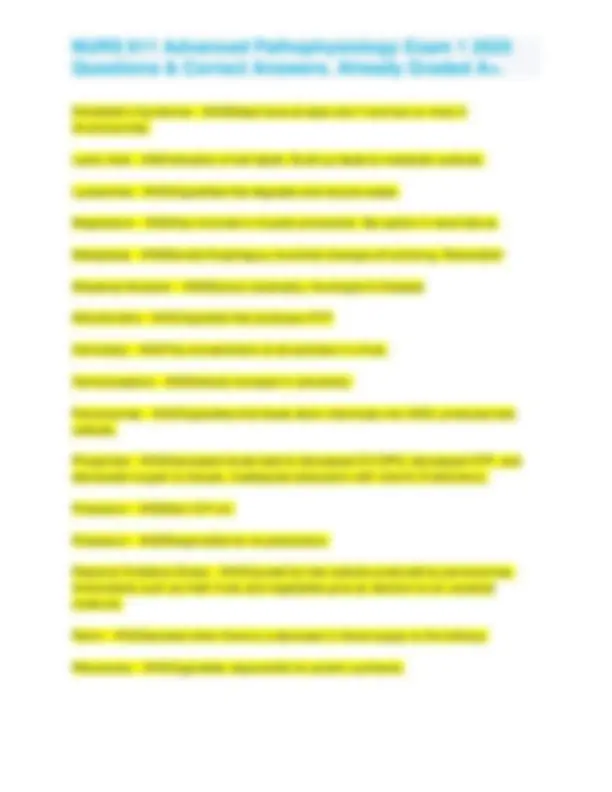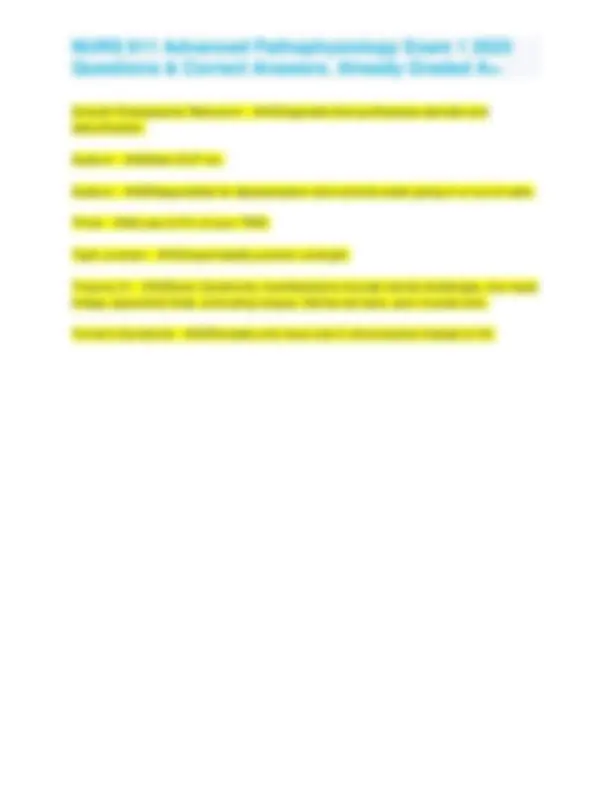




Study with the several resources on Docsity

Earn points by helping other students or get them with a premium plan


Prepare for your exams
Study with the several resources on Docsity

Earn points to download
Earn points by helping other students or get them with a premium plan
Community
Ask the community for help and clear up your study doubts
Discover the best universities in your country according to Docsity users
Free resources
Download our free guides on studying techniques, anxiety management strategies, and thesis advice from Docsity tutors
NURS 611 patho exam 1 & TEST BANK 2023-2024 COMPLETE QUESTIONS & CORRECT ANSWERS WITH RATIONALES. GRADED A+ (MARYVILLE UNIVERSITY).pdf
Typology: Exams
1 / 4

This page cannot be seen from the preview
Don't miss anything!



2 ATP - ANSHow much ATP can anaerobic respiration make? 36 ATP - ANSHow many ATP are produced in aerobic respiration? ACE Inhibitors - ANSStop ACE converting enzyme from converting angiotensin I to angiotensin II. Acetaldehyde - ANSAn intermediate in alcohol metabolism. Acidosis - ANSHyperventilation to blow off C02; kidneys excrete bicarb and reabsorb H+ ions. Active Transport - ANSEnergy-requiring movement of molecules across a membrane, example is Na/K pump. Aldosterone - ANSRetains salt. Alkalosis - ANSHypoventilation to hold onto C02; kidneys excrete bicarb and reabsorb H+ ions. Angiotensin II - ANSResponsible for vasoconstriction. Anti-Diuretic Hormone (ADH) - ANSActivated by increased plasma osmolality. Reabsorbs water and salt. Atrophy - ANSThymus gland, muscle wasting. Autosomal Dominant - ANSExpressed as big D. Examples are breast cancer, marfan syndrome, polycystic kidney disease, Huntington's Disease, hypertrophic obstructive cardiomyopathy. 50% recurrence risk for each child. Autosomal Recessive - ANSExpressed as small d. Must be homozygous (dd) to express disease. Examples are CF, taysachs, PKU, Wilson Disease, hemochromatosis, thalassemias.
Baroreceptors - ANSDetects increase in volume. Base Pair Substitution - ANSSickle cell. Calcium - ANSResponsible for muscle contraction. Decreased Plasma Oncotic Pressure - ANSHypoalbuminemia; eat more protein. Desmosomes - ANSJunctions that hold cells together by continuous bands or belts of epithelial sheets or button-like points of contact. Diffusion, Facilitated Diffusion, and Osmosis - ANSNon-energy forms of transport. Frameshift Mutation - ANSCrohn's; CF; some cancers. Gap Junction - ANSJunction that allows for conductivity, synchronizes contractions of cardiac muscle through ionic coupling. Golgi Apparatus - ANSOrganelle responsible for packaging and distribution. Hemosiderosis - ANSToo much iron in tissues. Hyperplasia - ANSLiver cell regeneration, endometrial. Hypertonic Fluid - ANSCauses cells to srhink. Hypertrophy - ANSMuscle growth, CHF. Hypotonic Fluid - ANSCauses cells to swell. Hypoxia - ANS#1 cause of cellular injury. Increased Capillary Hydrostatic Pressure - ANSHeart or kidney failure; remove the fluid. Increased Capillary Permeability - ANSBee sting or infection; antihistamine or treat underlying cause.
Smooth Endoplasmic Reticulum - ANSOrganelle that synthesizes steroids and detoxification. Sodium - ANSMain ECF ion. Sodium - ANSResponsible for depolarization and controls water going in or out of cells. Thirst - ANSLoss of 2% of your TBW. Tight Junction - ANSImpermeable junction; strength. Trisomy 21 - ANSDown Syndrome; manifestations include mental challenges, low nasal bridge, epicanthal folds, protruding tongue, flat/low set ears, poor muscle tone. Turner's Syndrome - ANSFemales only have one X chromosome instead of XX.